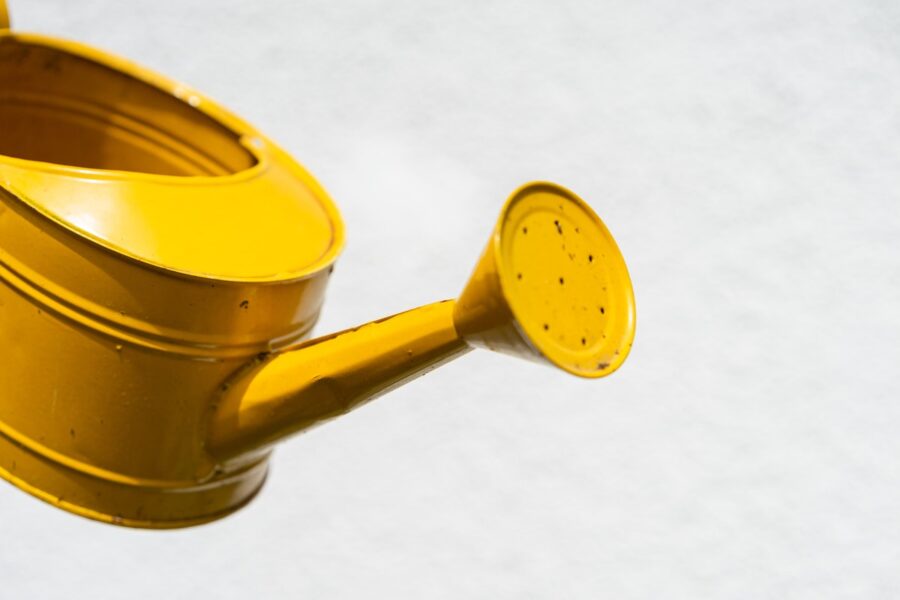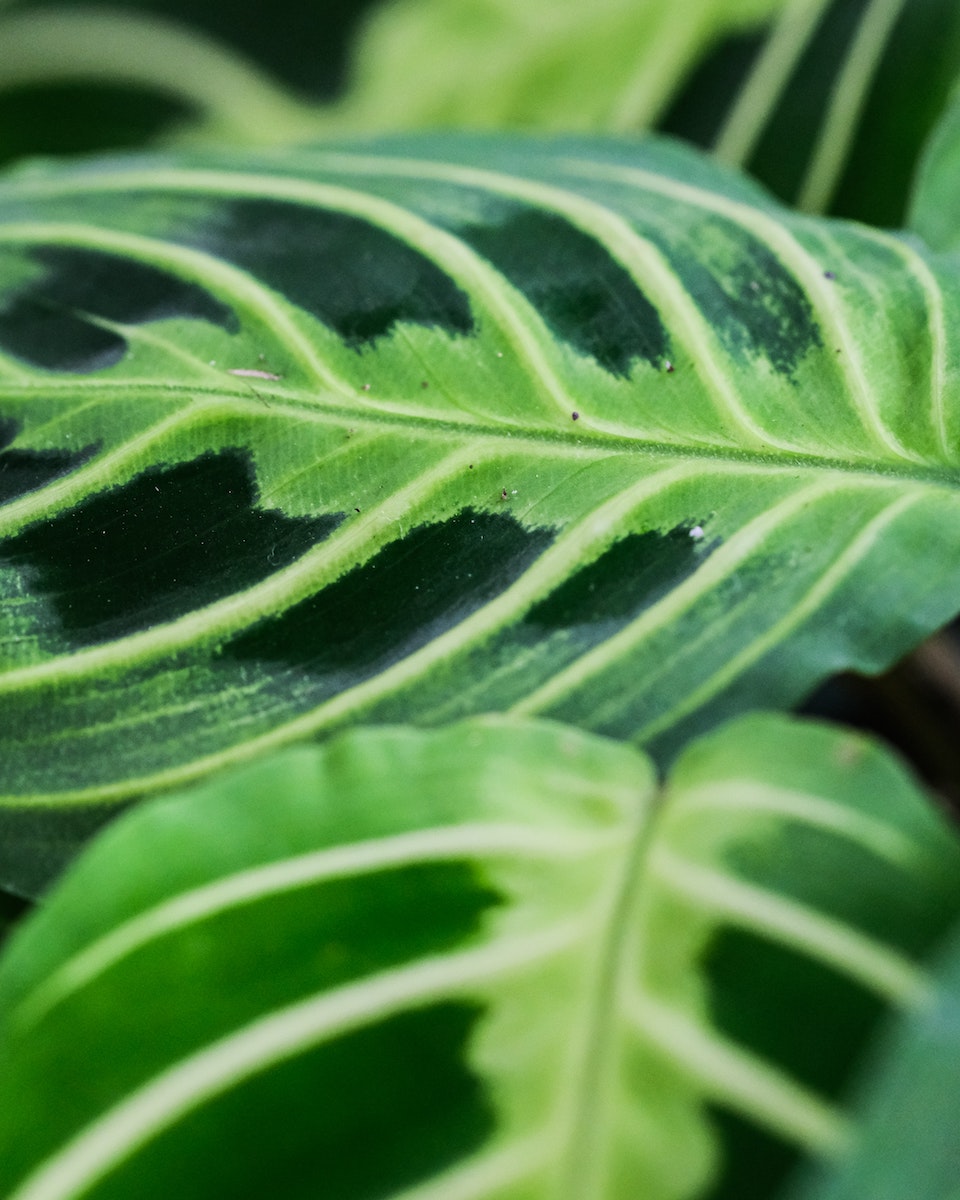Once you see a Maranta Lemon Lime, the chances are that you will think about its beautiful patterns until you purchase one!
The gorgeous plant makes an excellent addition to the intermediate gardener’s pot collection but if you’re a beginner plant parent, don’t let that discourage you. Our compact guide has all the information you need to grow a healthy Maranta Lemon Lime.
Table of Contents
Origins and Appearance
You might be wondering where this beautiful plant comes from. All Maranta varieties are native to Asia, Africa, and Brazil. More specifically, they flourish in Brazilian rainforests.
Of all the Maranta species, the Lemon Lime has the most striking appearance. It has large oval leaves with a fishbone pattern. Dark green shapes often appear between the “ribs.” The combined effect of stripes and different greens make this a spectacular house plant.
Fun fact: Maranta plants are also known as “prayer plants” because their leaves open and close (an action that resembles praying hands).
Temperature and Humidity
The Maranta Lemon Lime is a little fussy when it comes to its surroundings. Incorrect temperature and humidity can actually damage or kill this plant. Here’s a quick guide to keeping your Lemon Lime happy at the right toasty temperature.
- 60 to 80 degrees Fahrenheit ( 15.5 to 26.7 degrees Celsius).
- Humidity must be higher than 65 percent.
- Regular misting can also help to maintain correct humidity.
- Discontinue misting when you notice the formation of fungus.
- Keep out of direct sunlight.
- A Maranta likes filtered direct sunlight.
Watering

The bad news is that a Maranta Lemon Lime is more sensitive to water problems than most other houseplants. It doesn’t like to dry out nor will the plant do well when you give it too much water. But if you follow our tips, you should be fine!
During the colder months, you can reduce your watering schedule but during summer and spring, try to keep your Maranta slightly moist at all times. This is more difficult than it sounds because the danger of overwatering is always present.
On average, watering your Maranta once a week should suffice. Interestingly, this plant’s leaves also start to fold inward towards the centre when the plant wants water – so keep an eye out for that sign!
Try This Nifty Watering Trick
There is an alternative to keeping your Maranta moist at all times, a difficult task at best. Persistent moisture in soil could lead to a devastating fungus problem.
Many Maranta owners prefer not to take that risk so they wait until their plant dries out before they water it. The clever trick is not to let your Maranta stay dry for too long. Keep testing the soil with your finger and when it is completely dry, don’t wait too long to give the plant a good soaking.
Feeding

You don’t have to fertilize your Maranta during winter because during this time its growth rate slows down considerably. The rest of the year, you can feed the plant every two to four weeks.
A fair word of warning. Never use a strong commercial fertilizer for this species because it tends to damage the plant. The best feeding product for a Maranta Lemon Lime is a high-quality but gentle fertilizer. A good example is fish emulsion, a substance that is packed with nutrients and can also be given as often as you like and it will never burn your Maranta. As a bonus, it’s organic too!
A water-soluble fertilizer is best for a Maranta plant and fish emulsion ticks that box too. Your plant will flourish if you dilute the fertilizer at half-strength beforehand.
Soil and Repotting
More often than not, when you purchase a Maranta Lemon Lime from a nursery you have to repot the plant. Most nurseries stuff the pot with mixtures that hold water (they do this to save time by not having to water plants more often). If you water your new Maranta and the water drains through fairly quickly, then there’s no reason to repot until it needs a bigger container. But if the water drains slowly, you need to replace the soil as soon as possible.
General potting soil is usually sufficient. But if you love getting your hands dirty, you can also blend your own mix. A good recipe is equal parts of peat moss, perlite and potting soil. Don’t forget to choose a pot that comes with decent drainage holes to allow water to run through completely.
How to Repot Your Maranta Lemon Lime

Luckily, it’s not hard to repot a Maranta plant. Besides needing rescue from commercial nursery soil, your plant will also need a bigger pot as it grows. When the time comes, follow these easy steps to ensure a successful transfer.
- Gather a bigger pot that is clean and sterilized. Grab a good potting mix too.
- Fill the new pot with a few inches of soil.
- Lightly water the Maranta to loosen the soil.
- Leave the plant alone for about five minutes.
- Gently tilt the pot forward and tap the bottom to dislodge the rootball.
- Slide the plant out.
- Remove some of the soil around the rootball but not everything.
- Place the plant inside the new pot.
- Fill the sides up with soil.
- Gently water the plant.
Pruning
The Maranta plant has no seasonal requirements when it comes to pruning. However, when you remove dead, dying or extra leaves, your plant will respond with vigorous new growth. While you can prune the plant at any time, the ideal season is spring.
Pests and Diseases
Pests
The most common pests you’ll encounter (or hopefully not!) are mealybugs and spider mites. Mealybugs cause a cotton-like substance or white powder to appear on the plant. Spider mites leave behind threads and can even cause leaves to develop yellow speckles.
If you notice spider mites, you can wipe the plant with plant-based oil. This will destroy both the mites and their eggs. You can also spray them off with a strong stream of water, something that will also help with mealybugs.
Both can be prevented by applying an organic insecticide every now and again.
Diseases
There might come a time when you notice a spot on your plant and it just seems wrong. Let’s have a look at the most common indicators of Maranta plant disease.
- Leaf tips that curl or brown – too much sunlight.
- Watery spots on the leaves – overwatering (this can kill your plant if you keep watering too much)
- Mushy stems, yellow or wilting leaves, slow growth – root rot. Trim away any rotting roots and repot the plant.
FAQ

When fully grown, a Maranta plant can grow as high as 12 inches (30 cm). The leaves can spread outward as far as 14 inches (35.5 cm) while the leaves themselves can reach a size of 6 inches (15 cm).
When you live in an area where the Maranta is a native plant, rarity isn’t really a factor. But if you live in another country, it can be hard to find one and even then they often fetch a high price.
There is no serious toxicity with this plant. However, since children and pets are always vulnerable and tend to consume things they should rather not eat, always keep your Maranta safely out of their reach.
The best water for a Maranta is distilled water. However, if you cannot get distilled water, you can always fill a container with tap water and leave it overnight. That way, most of the harmful chemicals will evaporate.

